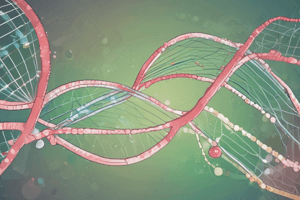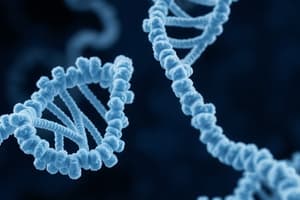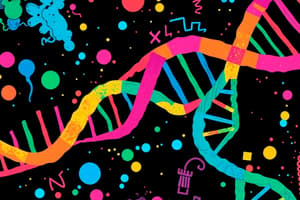Podcast
Questions and Answers
What process is necessary for the transport of protein and RNA through nuclear pores?
What process is necessary for the transport of protein and RNA through nuclear pores?
- Selective, energy-requiring transport (correct)
- Simple diffusion
- Passive transport
- Osmosis
What type of RNA is produced from the genes in the nucleus and is primarily involved in protein synthesis?
What type of RNA is produced from the genes in the nucleus and is primarily involved in protein synthesis?
- Ribosomal RNA (rRNA)
- Small nuclear RNA (snRNA)
- Transfer RNA (tRNA)
- Messenger RNA (mRNA) (correct)
What effect does phosphorylation have on the protein involved in Na+ transport?
What effect does phosphorylation have on the protein involved in Na+ transport?
- Phosphorylation causes the protein to change shape. (correct)
- Phosphorylation increases Na+ concentration inside the cell.
- Phosphorylation enhances K+ binding affinity.
- Phosphorylation prevents Na+ from binding.
What is the primary function of mRNA in the context of genetic expression?
What is the primary function of mRNA in the context of genetic expression?
What are nucleoli primarily involved in synthesizing?
What are nucleoli primarily involved in synthesizing?
In the Na+-Glucose symporter, what direction does Na+ flow?
In the Na+-Glucose symporter, what direction does Na+ flow?
Which type of endocytosis involves the engulfing of large particles?
Which type of endocytosis involves the engulfing of large particles?
How does the number of proteins produced in a cell compare to the number of genes?
How does the number of proteins produced in a cell compare to the number of genes?
What role do lysosomes play in the cell after phagocytosis?
What role do lysosomes play in the cell after phagocytosis?
What term refers to all of the proteins produced by the genome in an organism?
What term refers to all of the proteins produced by the genome in an organism?
What stage of genetic expression follows the synthesis of RNA?
What stage of genetic expression follows the synthesis of RNA?
Which process is characterized by the selective uptake of specific ligands through receptor binding?
Which process is characterized by the selective uptake of specific ligands through receptor binding?
What is the initial state of a primary lysosome?
What is the initial state of a primary lysosome?
Which statement about gene expression is true?
Which statement about gene expression is true?
What happens to K+ after it binds to the Na+ transport protein?
What happens to K+ after it binds to the Na+ transport protein?
Which type of endocytosis is known for sampling the extracellular environment through fluid intake?
Which type of endocytosis is known for sampling the extracellular environment through fluid intake?
What are the two polypeptide chains of insulin linked by?
What are the two polypeptide chains of insulin linked by?
What type of cell division results in gametes containing half the number of chromosomes?
What type of cell division results in gametes containing half the number of chromosomes?
During DNA replication, what is the role of DNA helicases?
During DNA replication, what is the role of DNA helicases?
How many amino acids are in the longer chain of insulin produced from proinsulin?
How many amino acids are in the longer chain of insulin produced from proinsulin?
What is produced at the end of DNA replication?
What is produced at the end of DNA replication?
What type of bond forms between adenine and thymine during DNA replication?
What type of bond forms between adenine and thymine during DNA replication?
Which enzyme is responsible for joining nucleotides together to form new DNA strands?
Which enzyme is responsible for joining nucleotides together to form new DNA strands?
What is the primary function of proinsulin before its conversion to insulin?
What is the primary function of proinsulin before its conversion to insulin?
What role do cyclin D proteins play in the cell cycle?
What role do cyclin D proteins play in the cell cycle?
What is the primary mechanism by which gene silencing occurs in epigenetic inheritance?
What is the primary mechanism by which gene silencing occurs in epigenetic inheritance?
What is the primary function of the p53 protein?
What is the primary function of the p53 protein?
How does the process of acetylation affect gene expression?
How does the process of acetylation affect gene expression?
What characterizes the relationship between oncogenes and proto-oncogenes?
What characterizes the relationship between oncogenes and proto-oncogenes?
What role does crossing-over play in genetic variation?
What role does crossing-over play in genetic variation?
Which of the following best describes apoptosis?
Which of the following best describes apoptosis?
Which of the following diseases is associated with problems in epigenetic inheritance?
Which of the following diseases is associated with problems in epigenetic inheritance?
Which factors can lead to the conversion of proto-oncogenes to active oncogenes?
Which factors can lead to the conversion of proto-oncogenes to active oncogenes?
What type of cell death is characterized by the swelling and rupture of cells?
What type of cell death is characterized by the swelling and rupture of cells?
What is a consequence of reduced DNA methylation in cancers?
What is a consequence of reduced DNA methylation in cancers?
What is the impact of epigenetic changes on identical twins?
What is the impact of epigenetic changes on identical twins?
What triggers the intrinsic pathway of apoptosis?
What triggers the intrinsic pathway of apoptosis?
What is a crucial function of tumor suppressor genes?
What is a crucial function of tumor suppressor genes?
What is the role of histone modifications in gene expression?
What is the role of histone modifications in gene expression?
Which of the following describes gene silencing that is inherited across generations?
Which of the following describes gene silencing that is inherited across generations?
What is a codon?
What is a codon?
What happens to proteins after they are synthesized on ribosomes attached to the rough endoplasmic reticulum?
What happens to proteins after they are synthesized on ribosomes attached to the rough endoplasmic reticulum?
What role does the leader sequence play in protein synthesis for secretion?
What role does the leader sequence play in protein synthesis for secretion?
Which statement about preproinsulin is true?
Which statement about preproinsulin is true?
How does the rough endoplasmic reticulum aid in the transport of proteins destined for secretion?
How does the rough endoplasmic reticulum aid in the transport of proteins destined for secretion?
What modification happens to insulin once it is in the rough ER?
What modification happens to insulin once it is in the rough ER?
During translation, how is the sequence of specific amino acids determined?
During translation, how is the sequence of specific amino acids determined?
Which of the following best describes the function of polyribosomes?
Which of the following best describes the function of polyribosomes?
Flashcards
Secondary Active Transport
Secondary Active Transport
Transport of a solute across a membrane using the potential energy stored in a concentration gradient created by a primary transporter.
Symporter
Symporter
A type of secondary active transporter that moves two solutes in the same direction.
Na+-Glucose Symporter
Na+-Glucose Symporter
A specific example of a symporter that transports sodium and glucose together.
Exocytosis
Exocytosis
Signup and view all the flashcards
Endocytosis
Endocytosis
Signup and view all the flashcards
Phagocytosis
Phagocytosis
Signup and view all the flashcards
Pinocytosis
Pinocytosis
Signup and view all the flashcards
Lysosome
Lysosome
Signup and view all the flashcards
Nuclear Pore
Nuclear Pore
Signup and view all the flashcards
mRNA
mRNA
Signup and view all the flashcards
Gene Expression
Gene Expression
Signup and view all the flashcards
Genetic Transcription
Genetic Transcription
Signup and view all the flashcards
Genetic Translation
Genetic Translation
Signup and view all the flashcards
Nucleolus
Nucleolus
Signup and view all the flashcards
Genome
Genome
Signup and view all the flashcards
Proteome
Proteome
Signup and view all the flashcards
Codon
Codon
Signup and view all the flashcards
Translation
Translation
Signup and view all the flashcards
What are polyribosomes?
What are polyribosomes?
Signup and view all the flashcards
Rough Endoplasmic Reticulum (RER)
Rough Endoplasmic Reticulum (RER)
Signup and view all the flashcards
Cisternae
Cisternae
Signup and view all the flashcards
Leader Sequence
Leader Sequence
Signup and view all the flashcards
Preproinsulin
Preproinsulin
Signup and view all the flashcards
Proinsulin
Proinsulin
Signup and view all the flashcards
Oncogene
Oncogene
Signup and view all the flashcards
Proto-oncogene
Proto-oncogene
Signup and view all the flashcards
Tumor Suppressor Gene
Tumor Suppressor Gene
Signup and view all the flashcards
p53
p53
Signup and view all the flashcards
Apoptosis
Apoptosis
Signup and view all the flashcards
Necrosis
Necrosis
Signup and view all the flashcards
Extrinsic Pathway of Apoptosis
Extrinsic Pathway of Apoptosis
Signup and view all the flashcards
Intrinsic Pathway of Apoptosis
Intrinsic Pathway of Apoptosis
Signup and view all the flashcards
Insulin Production
Insulin Production
Signup and view all the flashcards
DNA Replication
DNA Replication
Signup and view all the flashcards
DNA Helicase
DNA Helicase
Signup and view all the flashcards
Complementary Base Pairing
Complementary Base Pairing
Signup and view all the flashcards
DNA Polymerase
DNA Polymerase
Signup and view all the flashcards
Mitosis
Mitosis
Signup and view all the flashcards
Gametes
Gametes
Signup and view all the flashcards
Epigenetic Inheritance
Epigenetic Inheritance
Signup and view all the flashcards
DNA Methylation
DNA Methylation
Signup and view all the flashcards
Histone Modification
Histone Modification
Signup and view all the flashcards
Gene Silencing
Gene Silencing
Signup and view all the flashcards
Crossing Over
Crossing Over
Signup and view all the flashcards
Tetrad
Tetrad
Signup and view all the flashcards
Recombination
Recombination
Signup and view all the flashcards
Study Notes
The Cell
- The cell is the fundamental unit of structure and function in the body
- Cell functions are carried out by subcellular components called organelles
- Plasma membrane regulates communication between inside and outside the cell, and facilitates movement
- Cells appear simple under a light microscope, but their complex physiology is evident at subcellular level
Plasma Membrane and Associated Structures
- Composed of a phospholipid bilayer with embedded proteins
- Hydrophobic tails face inwards, hydrophilic heads face outwards
- Selectively permeable, controlling substances moving in and out
- Proteins facilitate specific transport and function as receptors, enzymes
- Contains carbohydrates (glycoproteins/glycolipids) as markers
- Cholesterol regulates flexibility
- Bulk transport processes (phagocytosis, endocytosis, exocytosis) enable movement of materials across the membrane
Cell Components and Functions
- Plasma membrane: Forms the outer boundary of the cell, controls material passage
- Cytoplasm: Contains organelles in a jelly-like substance (cytosol)
- Endoplasmic reticulum(ER): Rough ER (with ribosomes) processes proteins, smooth ER modifies them.
- Ribosomes: Synthesize proteins
- Golgi complex: Processes and packages proteins and other materials
- Mitochondria: Generate energy (ATP) through cellular respiration
- Lysosomes: Contain enzymes to digest cellular materials
- Peroxisomes: Detoxify harmful substances
- Centrosome: Helps organize cell division
- Vacuoles: Store substances
- Microfilaments and microtubules: Provide structural support and movement
- Cilia and flagella: Involved in cell movement
- Nuclear envelope: Encloses the nucleus, has pores for material passage
- Nucleolus: Involved in ribosome production
- Chromatin: Contains DNA, packages genetic material
Cytoplasm and Cytoskeleton
- Cytoplasm is the material within a cell encompassing the cytosol and organelles.
- The cytoskeleton includes microtubules and microfilaments providing structural support and movement.
- Organelles like the nucleus, vesicles, and proteins use the cytoskeleton as a transport system within the cell.
Cell Membrane and Transport
- The membrane is selectively permeable allowing some materials to pass but not others.
- Passive transport happens without energy expenditure. It includes diffusion (simple/facilitated).
- Osmosis is the movement of water across a membrane from a low concentration of solute to a high one.
- Active transport employs energy(ATP) to move materials against their concentration gradient.
- Active transport via vesicles enables the transport of large particles like in phagocytosis, pinocytosis, and receptor-mediated endocytosis
Cell Nucleus
- Most cells have a single nucleus. Exceptions include skeletal muscle and mature red blood cells.
- The nucleus is surrounded by a double membrane (nuclear envelope)
- Nuclear pores regulate the passage of molecules in and out of the nucleus
- Chromatin contains DNA which functions as a template for RNA and proteins
Genome and Proteome
- Genome refers to all genes in a cell
- Human genome contains around 25,000 genes
- Proteome refers to all the proteins that a genome produces
- The number of proteins exceeds genes because one gene can code for multiple proteins in a single cell.
RNA Synthesis
- Genes are DNA segments containing instructions for making specific proteins
- RNA synthesis copies genetic code from DNA to make mRNA
- RNA molecules (mRNA, tRNA, and rRNA) are essential in protein synthesis
Protein Synthesis and Secretion
- mRNA plays a crucial role in translating the genetic code into amino acid sequences for protein synthesis
- mRNA binds to ribosomes.
- Ribosomes translate mRNA's codons into amino acid sequences.
- Newly formed proteins undergo modifications and are sometimes dispatched from the cell
DNA Synthesis and Cell Division
- When a single cell replicates, each old strand serves as a template for a new strand
- Growth, repair, and reproduction are processes involving cell cycle stages and cell division.
Mitosis
- Mitosis involves cell division resulting in two daughter cells with the same number of chromosomes as the original cell
- Mitosis is the process of dividing a cell's nucleus, before cytoplasmic division
- The stages of mitosis are prophase, metaphase, anaphase, and telophase
Meiosis
- Meiosis is responsible for producing gametes (sperm/ova) with half the number of chromosomes, compared to a parent cell.
- Meiotic cell division results in four daughter cells.
- Crossing-over during meiosis promotes genetic diversity.
Hypertrophy and Hyperplasia
- Cells can increase in size (hypertrophy) or number (hyperplasia)
- Muscle growth from exercise is an example of hypertrophy.
- Callus formation demonstrates hyperplasia
Cell Death
- Cell death occurs naturally (apoptosis) or pathologically (necrosis)
- Apoptosis is a programmed cell suicide process helping the body rid itself of unneeded or damaged cells Apoptosis can be triggered by intrinsic(internal signals) or extrinsic (external factors) mechanisms
Mitochondria
- Found in the cells, except mature red blood cells, the main function is to produce energy (ATP)
- Mitochondria contains their own DNA which allows them to reproduce independently.
- Mitochondria are enveloped by two membranes, an inner and outer membranes.
Ribosomes
- Responsible for the production of proteins
- Found either free in the cytoplasm or attached to the endoplasmic reticulum.
- Ribosomes are composed of rRNA
Endoplasmic Reticulum (ER)
- A network of membranes extending throughout the cytoplasm
- There is rough (with ribosomes) and smooth ER
Golgi Complex
- A stack of flattened, membrane-bound sacs (cisternae) for the processing and packaging of proteins.
- Proteins move through the Golgi complex
Lysosomes
- Membrane-bound sacs containing digestive enzymes for the breakdown and recycling of cellular components.
- The role of lysosomes is recycling cell components
Clinical Applications
- Cell cycle abnormalities can play a role in tumors
- Stem cells can differentiate into various cell types, essential for tissue repair and development
- A malfunctioning cell cycle can lead to diseases like cancer.
- Apoptosis is a normal process eliminating damaged cells
- Understanding cell division/cell death can lead to new treatments for diseases
Epigenetic Inheritance
- Epigenetic inheritance is the passing of traits without changing the DNA sequence
- Changes to histone proteins and DNA methylation are examples of epigenetic mechanisms
- Genes can be silenced or reactivated without alterations to the DNA base sequence.
Protein Function
- Proteins play various roles in the cell including transport, catalysis, and structural support.
- Protein synthesis uses a genetic code translated by mRNA.
Studying That Suits You
Use AI to generate personalized quizzes and flashcards to suit your learning preferences.




